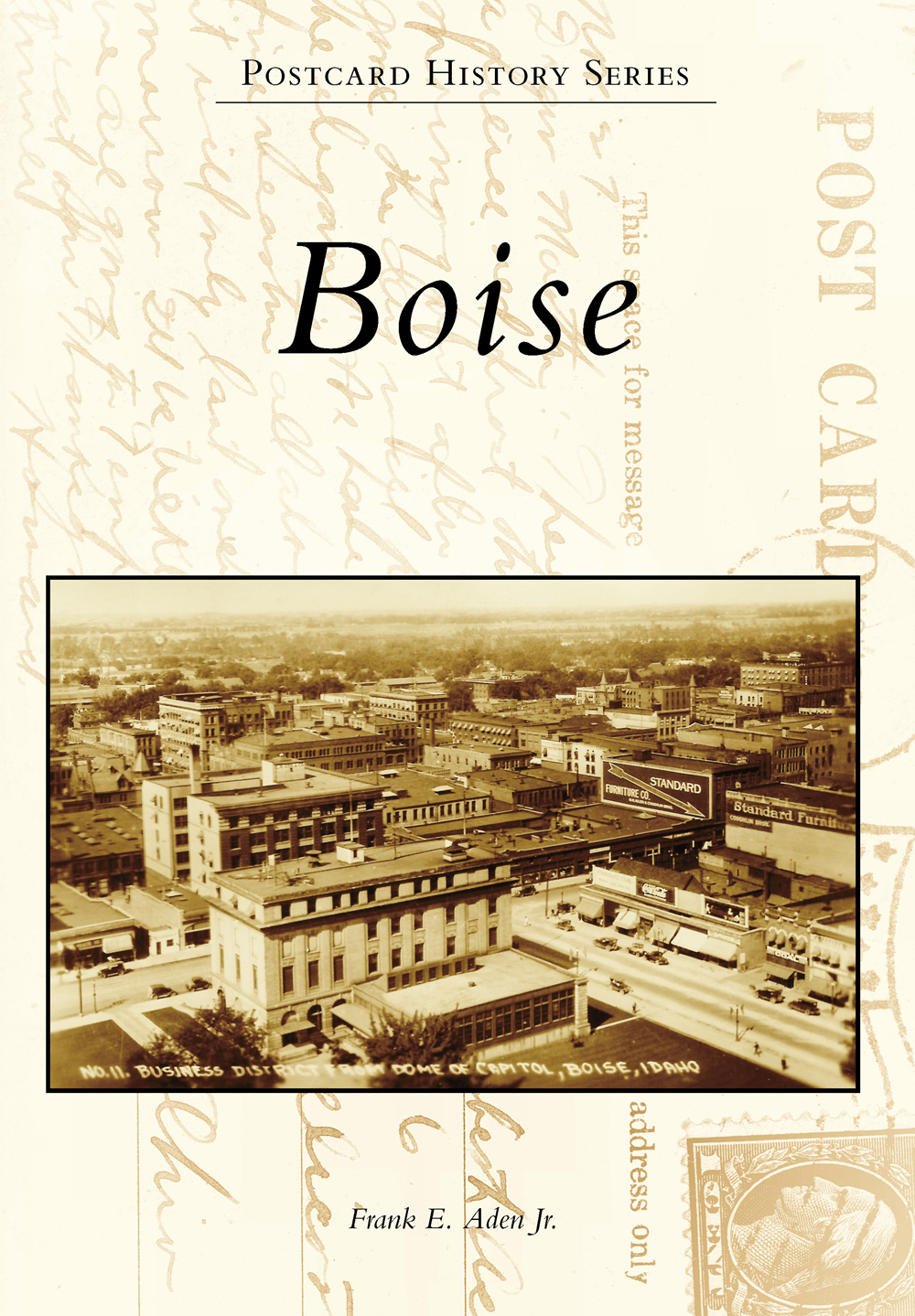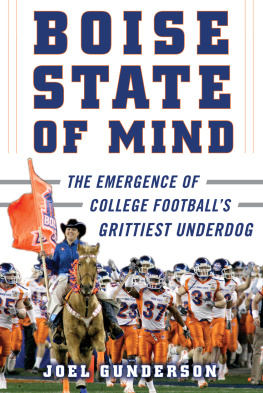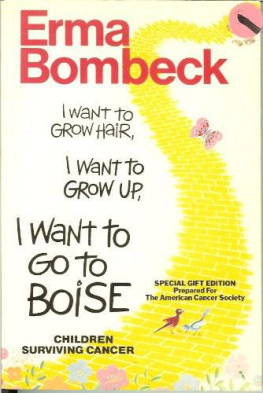
POSTCARD HISTORY SERIES
Boise
ON THE FRONT COVER: VIEW FROM CAPITOL DOME. Downtown Boise is seen from the capitol dome before 1931. The building to the right of the structure with the Standard Furniture sign was replaced with the Hotel Boise, which is now the Hoff Building. The Hotel Boise was completed in 19301931. (Authors collection.)
ON THE BACK COVER: NEW STATE CAPITOL, 1920. The new state capitol is seen around 1920. The center section of the capitol was started in 1906, and the wings were added in 1920. Both automobiles and horses are on the street. (Authors collection.)
POSTCARD HISTORY SERIES
Boise
Frank E. Aden Jr.

Copyright 2015 by Frank E. Aden Jr.
ISBN 978-1-4671-3256-5
Ebook ISBN 9781439649428
Published by Arcadia Publishing
Charleston, South Carolina
Library of Congress Control Number: 2014941127
For all general information contact Arcadia Publishing at:
Telephone 843-853-2070
Fax 843-853-0044
E-mail
For customer service and orders:
Toll-Free 1-888-313-2665
Visit us on the Internet at www.arcadiapublishing.com
I wish to dedicate this book to my parents, Frank and Lela Aden. I also dedicate this book to all who consider themselves Boiseans.
CONTENTS
ACKNOWLEDGMENTS
Around 1970, when I was in high school, I was given an old postcard of Boise. I was intrigued about how much the view had changed. From that time, whenever I went to an antiques store or a postcard or stamp show, I looked for old postcards of Boise. I was amazed about how many I found, even in cities outside the area when I went on trips. When online auctions became available, I checked every day to see if Boise postcards were available. Eventually, I found I had amassed over 300 postcards of Boise alone and realized that what I had was a very important record of Boise history. I thought that it would be great to make them available to historians of Boise in a book. I am grateful that Arcadia Publishing has made this possible. Unless otherwise noted, all postcards in the book are from the authors collection.
I would like to thank the following, who have helped me locate, identify, and research the postcards included in this book: Larry Adams, Mark Campbell, Bill Frahm, Art Gregory, Al Hale, Terry Hine, and my father, Frank Aden Sr.
I would also like to thank Dr. Peter Reedy and in memoriam Dr. Paul Ryan and Dr. William Vinning. Without them, this book would not have been possible.
INTRODUCTION
When people think of the Wild West, they imagine places like Tombstone, Dodge City (really a Midwest town), and Deadwood. Our perceptions have been influence by movies and television. The reality is much more interesting, and many towns and cities of the Old West do not always come to mind when the topic comes up. Boise is a perfect example of such a town.
The city was founded on the Oregon Trail in 1863, after the opening of the second Fort Boise. The fort was established to protect the miners who had flocked to the Boise Basin after the discovery of gold near Idaho City. Many more of these miners came from the west than from the east. Boise became the largest city on the Oregon Trail, not counting the trails terminus cities, and it remains so today. Prior to the founding of Fort Boise, the area was explored by fur trappers; it was they who really opened the area for further expansion.
Boise became an oasis on the Oregon Trail, established just south of the fort and just north of the Boise River. As the city grew, the Boise River made the region a strong agricultural area, with farms and ranches nearby. Many of the original sites are now well within city limits.
By 1864, Boise was the major financial center (even though still small) of the Idaho Territory, with the capital having been moved from Lewiston. For many, this is still a very controversial decision. By the late 1880s, Boise had a substantial downtown. After 1900, many multistoried buildings were erected. Passenger train service came to Boise in 1888 after a branch line was built from Nampa. The main line missed Boise, running from Mount Home to Kuna, then to Nampa, south of Boise.
Starting in the late 1800s, local farmers began diverting water from the Boise River in small canals. After 1900, small dams were built east of Boise that were used to divert water into permanent canals, such as the New York Canal, which runs from the Diversion Dam to Lake Lowell, south of Nampa. This made it possible for the expansion of farming and ranching in the Boise Valley, which helped the isolated town support itself.
By the 1920s, downtown Boise was the commercial center of the west Boise Valley. Downtown was home to the areas grocery, clothing, and furniture stores and was the center for doctors offices and pharmacies. Albertsons opened its first supermarket west of downtown, on Sixteenth and State Streets, in 1939, and many of the drugstores and grocery stores moved to the Boise Bench. Department stores, both local and national, were also centered downtown. Today, there are no major department stores or grocers in immediate downtown Boise. There were several theaters in downtown Boise until the mid-1960s. Of the original theaters, only the Egyptian exists today.
At the end of the 1960s and through the 1970s, Boise suffered urban renewal. Many buildings, including some historic structures, were torn down for a planned downtown mall. Many of Boises department stores had planned to move to the new mall with greatly expanded retail space. The downtown mall never got built, leaving many open lots where buildings had once stood. Many of these lots remained empty for years, making downtown look like a war zone, as one magazine commented. Starting in the mid-1970s, these lots were slowly filled in, with many turned into parking lots that remain today. Boise finally got its mall in 1988, on the bench, at Cole and Franklin Roads, the former location of a farm.
Downtown Boise had been the center of commerce for many years, but, with the expansion of the city into the valley and up onto the benches, many of the major highways coming into town, such as US 30, began to attract businesses. Some of the downtown retailers began to move to the new strip malls on these roads, turning them into major thoroughfares. Strip malls started to attract customers from downtown with their free parking. The first was Vista Village on Vista Street, built in 1949. Opened in the early 1960s, Hillcrest Center at Orchard Street and Overland Road, bringing new retailers to the valley. Streets like Fairview, Broadway, State, Overland, and Chinden (Garden City) became commercial retail centers. Downtown had several national five-and-dime chain stores, such as Kress, Woolworth, and Newberry. Woolworth moved to Hillcrest Center for a few years, then to Karcher Mall in Nampa. Kress went out of business in 1981, and Newberry and Woolworth followed in 1997. Karcher Mall opened in Nampa in 1965. It was the largest mall in the area until Boise Towne Square opened in 1988. It was also the first enclosed mall in the area. J.C. Penney continued to maintain its downtown store, offering mainly clothes and a catalog order desk. When it opened its Karcher store, it was the first full-line J.C. Penney in the state. The freeway (I-80 North, later renumbered I-84) had come to the Boise Valley in the early 1960s, making it easy for people in Boise to drive to Karcher Mall. Since the opening of Boise Towne Square, Karcher has struggled to survive.
As the years have gone by, the Boise Valley has become one big city. Boise, Meridian, Nampa, Caldwell, Garden City, and Eagle have begun to run together. The US Census Bureau now considers the area the Boise-Nampa Metropolitan Area, with over 650,000 people at the time of this writing. This is quite a change from the little frontier towns they once were.
Next page






